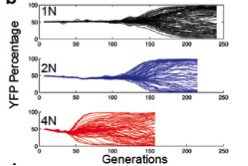 Doubling the compete sets of chromosomes, or tetraploidy, occurs commonly during organismal evolution and also is frequent in disease states, such as cancer. Theory suggests that increased chromosome sets might promote evolutionary adaptation, especially if many available beneficial mutations are dominant. Whole genome duplications can also alter cell physiology in poorly understood ways. For example, whole genome duplications often cause genetic instability. Using in vitro evolution of yeast, the Pellman group demonstrates that tetraploidy can increase the rate of evolutionary adaptation when cells are grown in a poor nutrient environment (published recently in Nature). Two different mathematical modeling approaches (collaborations with Franziska Michor’s and Roy Kishony’s labs) suggest that tetraploids have an increased rate of adaptive mutations and these mutations have stronger fitness effects. Whole genome sequencing of multiple evolved clones verified increased frequencies of mutations and chromosome rearrangements in tetraploids. A class of mutations was discovered that provide a fitness advantage only to the tetraploid strains. Together, these results provide quantitative analysis of the long discussed role of polyploidy in evolutionary adaptation.
Doubling the compete sets of chromosomes, or tetraploidy, occurs commonly during organismal evolution and also is frequent in disease states, such as cancer. Theory suggests that increased chromosome sets might promote evolutionary adaptation, especially if many available beneficial mutations are dominant. Whole genome duplications can also alter cell physiology in poorly understood ways. For example, whole genome duplications often cause genetic instability. Using in vitro evolution of yeast, the Pellman group demonstrates that tetraploidy can increase the rate of evolutionary adaptation when cells are grown in a poor nutrient environment (published recently in Nature). Two different mathematical modeling approaches (collaborations with Franziska Michor’s and Roy Kishony’s labs) suggest that tetraploids have an increased rate of adaptive mutations and these mutations have stronger fitness effects. Whole genome sequencing of multiple evolved clones verified increased frequencies of mutations and chromosome rearrangements in tetraploids. A class of mutations was discovered that provide a fitness advantage only to the tetraploid strains. Together, these results provide quantitative analysis of the long discussed role of polyploidy in evolutionary adaptation.
Figure legend:
Evolution experiments were performed by batch culture of genetically identical strains, differing only by ploidy. The experiment starts with a 50:50 mix of otherwise identical YFP and CFP-labeled cells. Deviation from 50% YFP cells indicates adaptation.